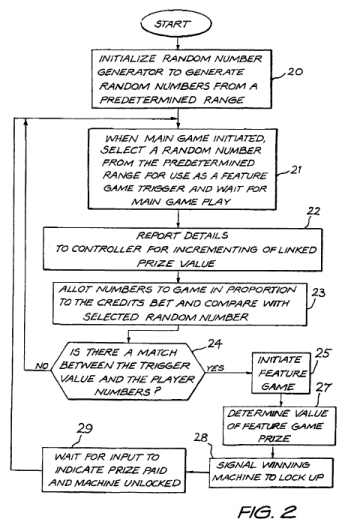 Aristocrat Tech. Australia v. Int’l Game Tech., Dtk No. 2010-1426 (Fed. Cir. 2013).
Aristocrat Tech. Australia v. Int’l Game Tech., Dtk No. 2010-1426 (Fed. Cir. 2013).
Aristocrat sued IGT alleging that IGT’s gambling game devices infringed U.S. Patent No. 7,056,215 (“the ’215 patentâ€) and U.S. Patent No. 7,108,603 (“the ’603 patentâ€). The district court granted summary judgment of non-infringement. This case presented an issue of direct vs. indirect infringement because certain claim language was interpreted to require a user/player to perform a step. In order for a party to be liable for direct infringement, “that party must commit all the acts necessary to infringe the patent, either personally or vicariously.†Therefore, in this case, if a player/user was required to perform a step, then IGT would not be liable for direct infringement.
Claim construction. Claim 1 of the ‘215 patent provided system included the following disputed claim language: (1) “awarding said one progressive prize†and (2) “making a wagerâ€.
The Federal Circuit found that “awarding said one progressive prize†required the conferring of rights from the operator of the game to the player and not simply displaying the amount of the prize won. Therefore the actions by IGT’s employees in testing the game were not an infringing activity because during the testing of gaming machines legal entitlement to a prize is never conferred upon IGT employees.
The court also found that “making a wager” meant “betting, which is an act performed by the player” not simply processing a bet by the device.
Direct Infringement. The court found that under the properly construed claims no single actor performed all the steps of the claim. Further the court found that the acts of the user/player could not be imputed to the casino. The court stated “One party’s direction or control over another in a principal-agent relationship or like contractual relation-ship operates as an exception to this general rule, but absent that agency relationship or joint enterprise, we have declined to find one party vicariously liable for another’s actions.” The court found that IGT had no relationship with the player so as to impute the actions of the player to IGT. As a result, the court found no direct infringement.
Indirect infringement. The court reversed and remanded on the issue of indirect infringement, allowing the plaintiff to press its indirect infringement claims. The court stated, “[a] party who knowingly induces others to engage in acts that collectively practice the steps of the patented method—and those others perform those acts—has had precisely the same impact on the patentee as a party who induces the same infringement by a single direct infringer; there is no reason, either in the text of the statute or in the policy underlying it, to treat the two inducers differently.â€
[gview file=”http://www.waltmire.com/blog/wp-content/uploads/2013/03/FedCirAristocrat_v_InternationalGame10-1426.pdf”]